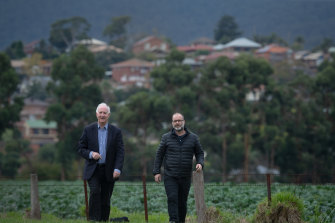If housing keeps concreting over land previously used for farming, they say reliance on imported food will become the norm.
 |
| Farmland on Melbourne's city fringe has been central to how well Melbourne is coping during the coronavirus pandemic, academics Michael Buxton (L) and Andrew Butt say. |
“Urban sprawl and rural subdivision could halve Melbourne’s peri-urban food production capacity,” said Andrew Butt, from meeting 41 per cent of the city’s current food needs now to just 18 per cent by 2050.
Professor Butt and Michael Buxton, two RMIT planning academics, have this month released a new book, The Future of the Fringe, published by the CSIRO. In it, they show that a quarter of Australia’s agricultural production now comes from land on city fringes.
“In this pandemic, both food production and supply chains have proved increasingly vulnerable,” Professor Buxton said. “Dependency on international and interstate food assumes that stable conditions will continue, but long and complex supply chains can be disastrous in a crisis."
Read the story from The Age by Clay Lucas - “Planners say pandemic shows farmland on city fringes is crucial.”

No comments:
Post a Comment